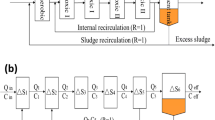Abstract
Dissimilative reduction of nitrite by nitrite-acclimated cellswas investigated in a batch reactor under various environmental conditions that can beencountered in shortcut biological nitrogen removal (SBNR: ammonia to nitrite andnitrite to nitrogen gas). The maximum specific nitrite reduction rate was as much as 4.3 times faster than the rate of nitrate reduction when individually tested, but the reaction was inhibited in the presence of nitrate when the initial nitrate concentration was greater than approximately 25 mg-N/l or the initialNO -3 N/NO -2 N ratio was larger than 0.5. Nitrite reduction was also inhibited by nitrite itself when theconcentration was higher than that to which the cells had been acclimated. Therefore, it was desirable to avoid excessively high nitrite and nitrate concentrations in a denitrification reactor. Nitrite reduction, however, was not affected by an alkaline pH (in the range of 7–9) or a high concentration of FA (in the range of 16–39 mg/l), which can be common in SBNR processes. The chemical oxygen demand (COD) requirement for nitrite reduction was approximately 22–38% lower than that for nitrate reduction, demonstrating that the SBNR process can be economical. The specific consumption,measured as the ratio of COD consumed to nitrogen removed, was affected by the availability of COD and the physiological state of the cells. The ratio increased when the cells grew rapidly and were storing carbon and electrons.
Similar content being viewed by others
References
Abeling U & Seyfried CF (1992) Anaerobic-aerobic treatment of high strength ammonium wastewater nitrogen removal via nitrite. Water Sci. Tech. 26: 1007-1015
Akunna JC, Bizeau C & Moletta R (1993) Nitrate and nitrite reductions with anaerobic sludge using various carbon sources: glucose, glycerol, acetic acid, lactic acid and methanol. Water Res. 27: 1303-1312
Almeida JS, Reis MAM & Carrondo MJT (1995a) Competition between nitrate and nitrite reduction in denitrification by Pseudomonas fluorescens. Biotechnol. Bioengng 46: 476-484
Almeida JS, Julio SM, Reis MAM & Carrondo MJT (1995b) Nitrite inhibition of denitrification by Pseudomonas fluorescens. Biotechnol. Bioengng 46: 194-201
Anthonisen AC, Loehr RC, Prakasam TBS & Srinath EG (1976) Inhibition of nitrification by ammonia and nitrous acid. J. Water Pollut. Control. Fed. 48: 835-852
APHA, AWWA & WEF (1998) Standard Methods for the Examination of Water and Wastewater. 19 edn. Washington, DC
Bae W, Baek SC, Chung JW & Lee YW (2002) Nitrite accumulation in batch reactor under various operational conditions. Biodegradation 12: 359-366
Beccari M, Passino R, Ramadori R & Tandoi V (1983) Kinetics of dissimilatory nitrate and nitrite reduction in suspended growth culture. J. Water Pollut. Control. Fed. 55: 58-64
Blaszczyk M (1983) Effect of various sources organic carbon and high nitrite and nitrate concentrations on the selection of denitrifying bacteria. II. Continuous cultures in packed bed reactors. Acta Microbiologica Polonica 32: 65-71
Brittain T, Blackmore R, Greenwood C & Thomson AJ (1992) Bacterial nitrite-reducing enzymes. J. Biochem. 209: 793-802
Carlson CA & Ingraham JL (1983) Comparison of denitrification by Pseudomonas stutzeri, Pseudomonas aeruginosa, and Paracoccus denitrificans. Appl. Environ. Microbiol. 45: 1247-1253
Chen SK, Juaw CK & Cheng SS (1991) Nitrification and denitrification of high-strength ammonium and nitrite wastewater with biofilm reactor. Water Sci. Tech. 23: 1417-1425
Chung JW (2002) Factors affecting nitrite accumulation and process optimization in a shortcut biological nitrogen removal hybrid reactor. Ph.D. thesis. Hanyang University
Carlson CA & Ingraham JCL (1983) Comparison of denitrification by Pseudomonas stutzeri, Pseodomonas aeruginosa, and Paracoccus denitrificans. Appl. Environ. Microbiol. 45: 1247-1253
Hallin S, Rothman M & Pell M (1996) Adaptation of denitrifying bacteria to acetate and methanol in activated sludge. Water Res. 30: 1445-1450
Hellinga C, Schellen AAJC, Mulder JW, Loosdrecht MCM & Heijnen JJ (1998) The SHARON process: an innovative method for nitrogen removal from ammonium-rich wastewater. Water Sci. Tech. 37: 135-142
Hochstein LI & Tomlinson GA (1988) The enzymes associated with denitrification. A. Rev. Microbiol. 42: 231-261
Kučcera I, Matyášek R & Dadák V (1986) The influence of pH on kinetics of dissimilatory nitrite reduction in Paracoccus denitrificans. Biochimica et Biophysica Acta 848: 1-7
Moreno-Vivian C, Cabello P, Martinez-Luque M, Blasco R & Castillo F (1999) Prokarytic nitrate reduction: molecular properties and functional distinction among bacterial nitrate reductases. J. Bacteriol. 181: 6573-6584
Rittmann BE & McCarty PL (2001) Environmental Biotechnology: Principles and Applications. McGraw-Hill, New York
Sauter LJ & Alleman JE (1981) A streamlined approach to biological nitrogen removal. Proc. ASCE Specialty Cong. Environ. Engr. (pp 296-306). New York
Schulthess RV, Kühni M & Gujer W (1995) Release of nitric and nitrous oxides from denitrifying activated sludge. Water Res. 29: 215-226
Stouhamer AH (1988) Dissimilatory reduction of oxidized nitrogen compounds. In: Zehnder AJB (Ed) Biology of Anaerobic Microorganisms (pp 242-303). John Wiley, New York
Timmermans P & Van Haute A (1983) Denitrification with methanol. Fundamental study of the growth and denitrification capacity of Hyphomicrobium sp. Water Res. 17: 1249-1225
Turk O & Mavinic DS (1987) Selective inhibition: a novel concept for removing nitrogen from highly nitrogeneous wastes. Env. Technol. Lett. 8: 419-426
Turk O & Mavinic DS (1989a) Stability of nitrite build-up in an activated sludge system. J. Water Pollut. Control. Fed. 6: 1440-1448
Turk O & Mavinic DS (1989b) Maintaining nitrite build-up in a system acclimated to free ammonia. Water Res. 23: 1383-1388
Van Verseveld HW & Stouthamer AH (1978) Electron-transport chain and coupled oxidative phosphorylation in methanol-grown Paracoccus denitrificans. Arch. Microbiol. 118: 13-20
Villaverde S, Fdz-Polanco F & Garcia PA (2000) Nitrifying biofilm acclimation to free ammonia in submerged biofilters. Start-up influence. Water Res. 34: 602-610
Wilderer PA, Jones WL & Dau U (1987) Competition in denitrification systems affecting reduction rate and accumulation of nitrite. Water Res. 21: 239-245
Yang L & Alleman JE (1992) Investigation of batchwise nitrite build-up by enriched nitrification culture. Water Sci. Tech. 26: 997-1005
Author information
Authors and Affiliations
Rights and permissions
About this article
Cite this article
Chung, J., Bae, W. Nitrite reduction by a mixed cultureunder conditions relevant to shortcut biologicalnitrogen removal. Biodegradation 13, 163–170 (2002). https://doi.org/10.1023/A:1020896412365
Issue Date:
DOI: https://doi.org/10.1023/A:1020896412365




